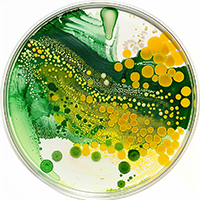Scientific Posters
Zymo Research's scientific posters highlight the latest breakthroughs in molecular biology, showcasing innovations spanning from epigenetics to microbiomics. We are proud to present insights from our collaborations with leading scientists and institutions worldwide, with more contributions to the field of life science on the horizon.
Featured Poster

An Integrated Approach for Pathogen Detection, AMR Monitoring, and Functional Analysis in Wastewater
X. Cheng , J. Wilkinson, K. Ngo , P. Baybayan, Y. Kim, P. Pham, E. Carrasco, S. Tang, J. Shen, and K. LockenWastewater surveillance has emerged as a pivotal tool in public health epidemiology. Particularly catalyzed by the Covid-19 pandemic, modern culture-independent sequencing methods have become indispensable due to their ability to offer a comprehensive perspective.
View PosterIncreasing Reliability of Microbiome Diagnostics of GI Disease by Sample Preservation of Stool and Automated Unbiased Nucleic Acid Extraction
Kevin Lin, Luigi Basilio, Shuiquan Tang, Stanislav Forman, Ryan Kemp, and Xi Yu JiaBackground: The gut microbiota has long been associated with GI diseases including, Crohn's disease, ulcerative colitis, and inflammatory bowel disease. Understanding the gut microbiota holds promise for earlier clinical diagnosis of these types of diseases. However, diagnostic success is predicated on accurate detection of microbes in the stool and oftentimes sample degradation or changes can occur due to improper storage which leads to biased results. To combat this, we evaluated a sample collection medium that preserves genetic profiles, inactivates pathogens, and is suitable for direct automated nucleic acid extraction. Methods: Human stool samples were subjected to storage in DNA/RNA Shield™ (preservation medium) versus unprotected samples at ambient temperatures and were also subjected to repeated freeze-thawing cycling from -80°C. After bead-beating homogenization, DNA was extracted using an automated microbiome workflow on a Tecan Fluent™. Microbial profiles were analyzed using 16S rRNA gene sequencing on Illumina® MiSeq™ targeting the V3-V4 region. Additionally, a mock microbial standard of various gram positive/negative bacteria and yeast species were used to test the performance of various extraction methods to determine efficiency of lysis. Results: Microbial composition in preserved stool was unchanged up to 1 month and was unaffected by freeze thaw (up to 10 cycles). Unprotected samples experienced a shift in microbial profiles in as little as one day with unaccounted microbial growth. Overall, there was a complete loss of Bacteroides and significant increase in Actinobacteria in as little as 5 freeze thaw cycles. A majority of extraction methods also revealed a bias toward gram negative species that portrayed a skewed representation of the microbiome. Conclusions: Microbial profiles remained consistent at ambient temperatures when stool was stored in DNA/RNA Shield™. Furthermore, the preservation medium facilitated nucleic acid extraction and was amenable for direct automated processing on various instrumentation and chemistries.
View PosterOneStep qMethyl™ Panel: A Method To Indicate Pluripotency and Characterize Human Embryonic Stem Cells
Lam Nguyen, Jill Petrisko, Manuel Krispin, Xi-Yu JiaPluripotency is the ability of embryonic stem cells to differentiate into multiple cell types. Pluripotent cells have epigenetic signatures that reflect their ability to generate multiple cell types. Different DNA methylation patterns in gene regions vary between pluripotent and differentiated cells as a result of processes such as development, carcinogenesis, genomic imprinting disorders, and cell reprogramming. In human pluripotent cells, gene promoter regions in the NANOG, RAB25, and PTPN6 genes have been shown to maintain low levels of DNA methylation compared to differentiated cell types. Conversely, gene promoter regions of MGMT, GBP3, and LYST have been shown to maintain high levels of methylation in pluripotent cells compared to differentiated cell types. Here we present a simple, straightforward, and bisulfite-free procedure for rapid, DNA methylation assessment for the above mentioned genes.
View PosterOrganic Extraction of RNA From Animal and Plant Tissues Without Phase Separation
Stanislav Forman , Danice Anne A. Cabaya , Xi Yu JiaOrganic acid-guanidinium-phenol based extraction is widely implemented for most plant and animal RNA purification protocols. This organic extraction method effectively inactivates nucleases and infectious agents and allows for adequate sample storage and stabilization. However, limitations of existing organic extraction methods become apparent with high-throughput processing and the handling of small volume inputs. In both cases, the requirement of phase separation can affect both the yield and purity of RNA. Here we present an alternative acid-guanidinium-phenol based procedure that effectively bypasses phase separation/precipitation steps with a spin column and specially designed washes. This helps to eliminate problems attributed to phenol carryover that is often associated with conventional organic extraction methods. This new “Direct-zol™” procedure maximizes total RNA recovery, including small RNAs, without the need for a carrier. For tough-to-lyse plant and animal tissue the Direct-zol™ procedure can be combined with unique BashingBead™ and OneStep inhibitor removal technologies for unparalleled yields and complete removal of polyphenolic inhibitors to RT-PCR, respectively. The Direct-zol™ procedure delivers DNA-free RNA that is ideal for RT-PCR, RNA-seq (expression profiling), hybridization, etc.
View PosterPluripotency Prediction Using a Key Set of Six Epigenetic Biomarkers
Jill Petrisko, Lam Nguyen, Manuel Krispin, Xi Yu JiaThe ability to accurately characterize the pluripotent state of human embryonic stem (ES) cells or induced pluripotent stem (iPS) cells is paramount to the field of human stem cell research. Pluripotent stem cells display cell morphology, cell surface markers, a gene expression profile, and an epigenetic signature distinct from that of partially or fully differentiated cells. Routine measures employed to characterize the pluripotent state of an ES or iPS cell line include embryoid body formation, karyotyping, expression of transcription factors OCT4, SOX2, and NANOG, expression of specific cell surface antigen markers such as SSEA and TRA, and more recently, characterization of the cells' epigenetic profile. Genome-wide DNA methylation signatures for human ES and iPS cell lines have been studied using both reduced-representation bisulfite sequencing (RRBS) (Bock et al. 2010) and bead array platforms (Bibikova et al. 2006). While these genome-wide methods are the most accurate means for characterizing the epigenetic variability among ES and iPS cells lines, they are expensive and cumbersome for high-throughput research laboratories wanting to routinely monitor the quality of their pluripotent cell lines.
View PosterDNA Methylation Markers for the Surveillance of Non-Muscle Invasive Bladder Cancer: Results from a Prospective Pilot Study
Paolo Piatti, Sanam Ladi-Seyedian, Sidney Roberts, Farshad Sheybaee Moghadam, Alireza Ghoreifi, Jeffrey Bhasin, Benjamin Jara, Lucy Sanossian, Yap Ching Chew, Sumeet Bhanvadia, Hooman Djaladat, Anne Schuckman, Gangning Liang, Siamak DaneshmandCystoscopy and urine cytology are routinely employed during follow-up of patients with a history of non-muscle invasive bladder cancer (NMIBC) due to the high recurrence rate of this disease. Diagnostic accuracy of FDA approved urine-based tests is suboptimal. Herein, we compare the diagnostic value of urine cytology and a newly developed urine-based DNA methylation test (Bladder CARE™) for surveillance of NMIBC
View Poster
